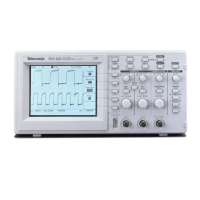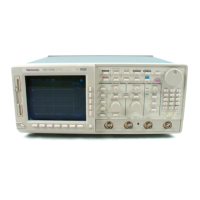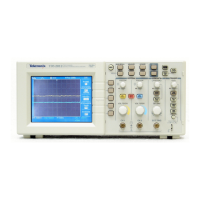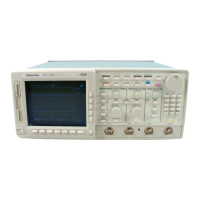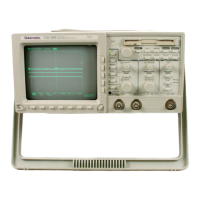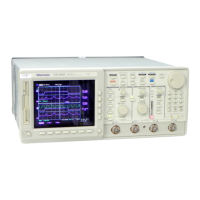Fast Fourier Transforms
TDS 420A, TDS 430A, TDS 460A & TDS 510A User Manual
3–35
Adjust for a Non-Clipped Display. To properly display your FFT waveform, scale
the source waveform so it is not clipped:
Scale and position the source waveform so it is contained on screen. (Off
screen waveforms may be clipped, resulting in errors in the FFT waveform.
If you use off screen waveforms, turn on Pk-Pk in the measurement menu
and monitor the source waveform for clipping.)
Use vertical position and vertical offset to position your source waveform.
As long as the source waveform is not clipped, its vertical position and
vertical offset will not affect your FFT waveform except at DC. (DC
correction is discussed below.)
Adjust Offset and Position to Zero for DC Correction. Normally, the output of a
standard FFT computation yields a DC value that is twice as large as it should be
with respect to the other frequencies. Also, the selection of window type
introduces errors in the DC value of an FFT.
The displayed output of the FFT on TDS oscilloscopes is corrected for these
errors to show the true value for the DC component of the input signal. The
Position and Offset must be set to zero for the source waveform in the Vertical
menu. When measuring the amplitude at DC, remember that 1 VDC equals 1
V
RMS
and the display is in dB.
Most often, you will want to use a short record length because more of the FFT
waveform can be seen on screen and long record lengths can slow oscilloscope
response. However, long record lengths lower the noise relative to the signal and
increase the frequency resolution for the FFT. More important, they might be
needed to capture the waveform feature you want to include in the FFT.
To speed up oscilloscope response when using long record lengths, you can save
your source waveform in a reference memory and perform an FFT on the saved
waveform. That way the DSP will compute the FFT based on saved, static data
and will only update if you save a new waveform.
Selecting the right acquisition mode can produce less noisy FFTs.
Set up in Sample or Normal Mode. Use sample mode until you have set up and
turned on your FFT. Sample mode can acquire repetitive and nonrepetitive
waveforms and does not affect the frequency response of the source waveform.
Hi Res and Average Reduce Noise. After the FFT is set up and displayed, it might
be useful to turn on Hi Res mode, to reduce the effect of noise in the signal.
However, Hi Res does affect the frequency response of the source waveform.
Record Length
Acquisition Mode
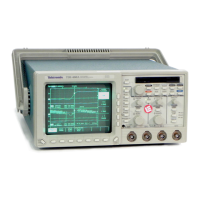
